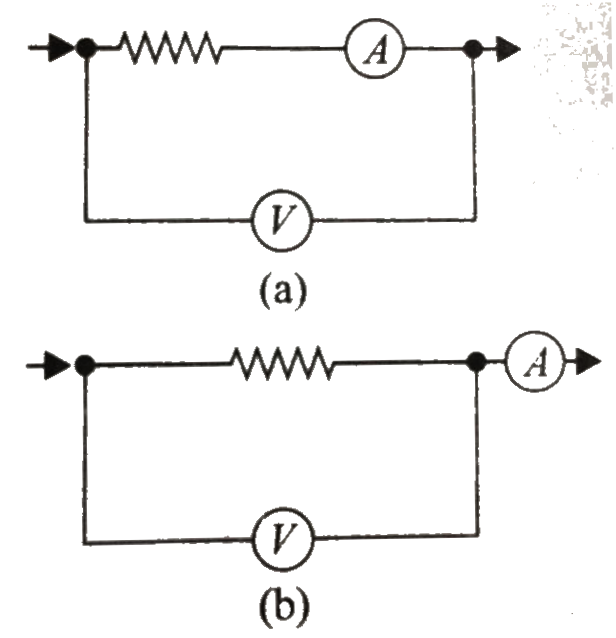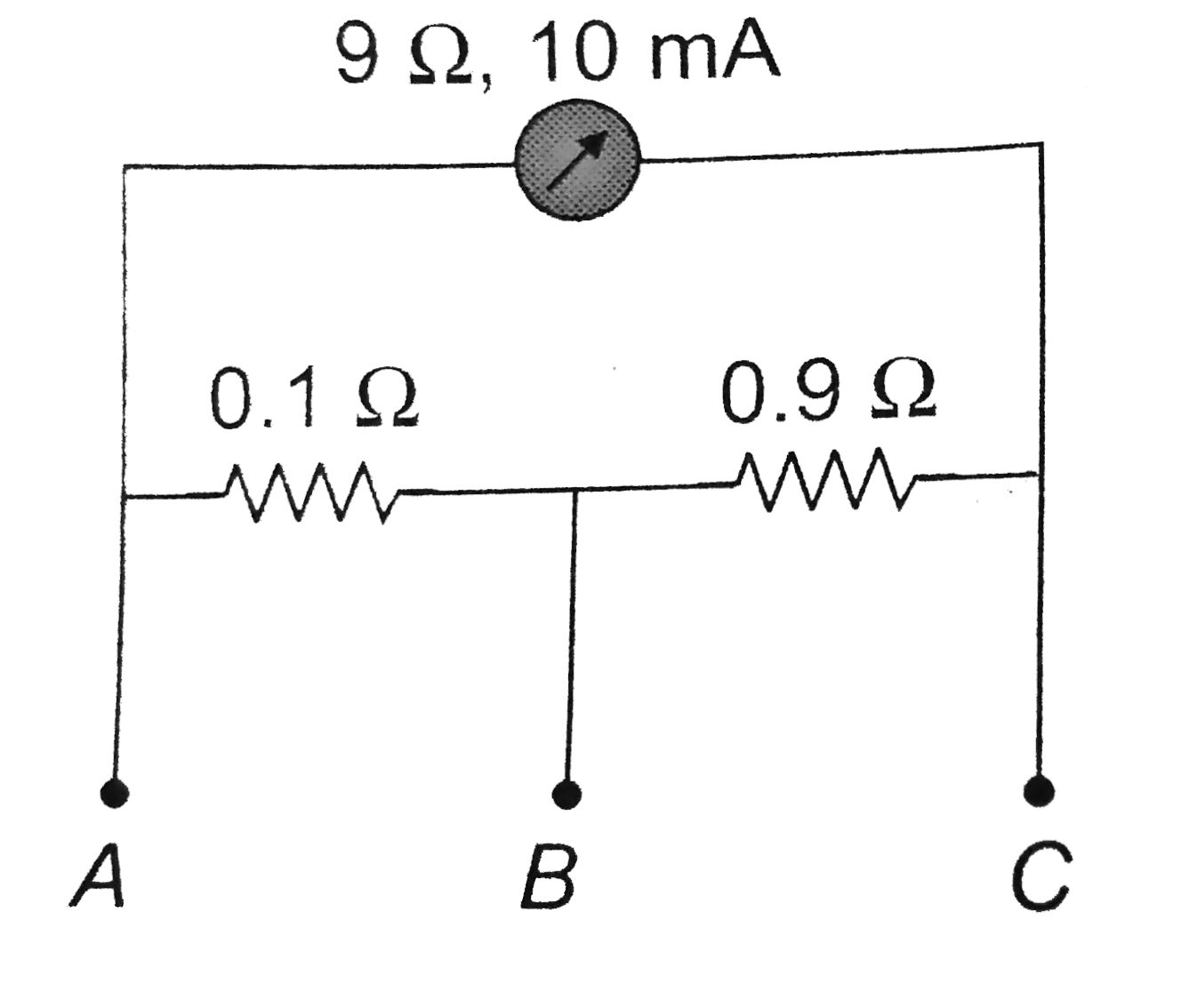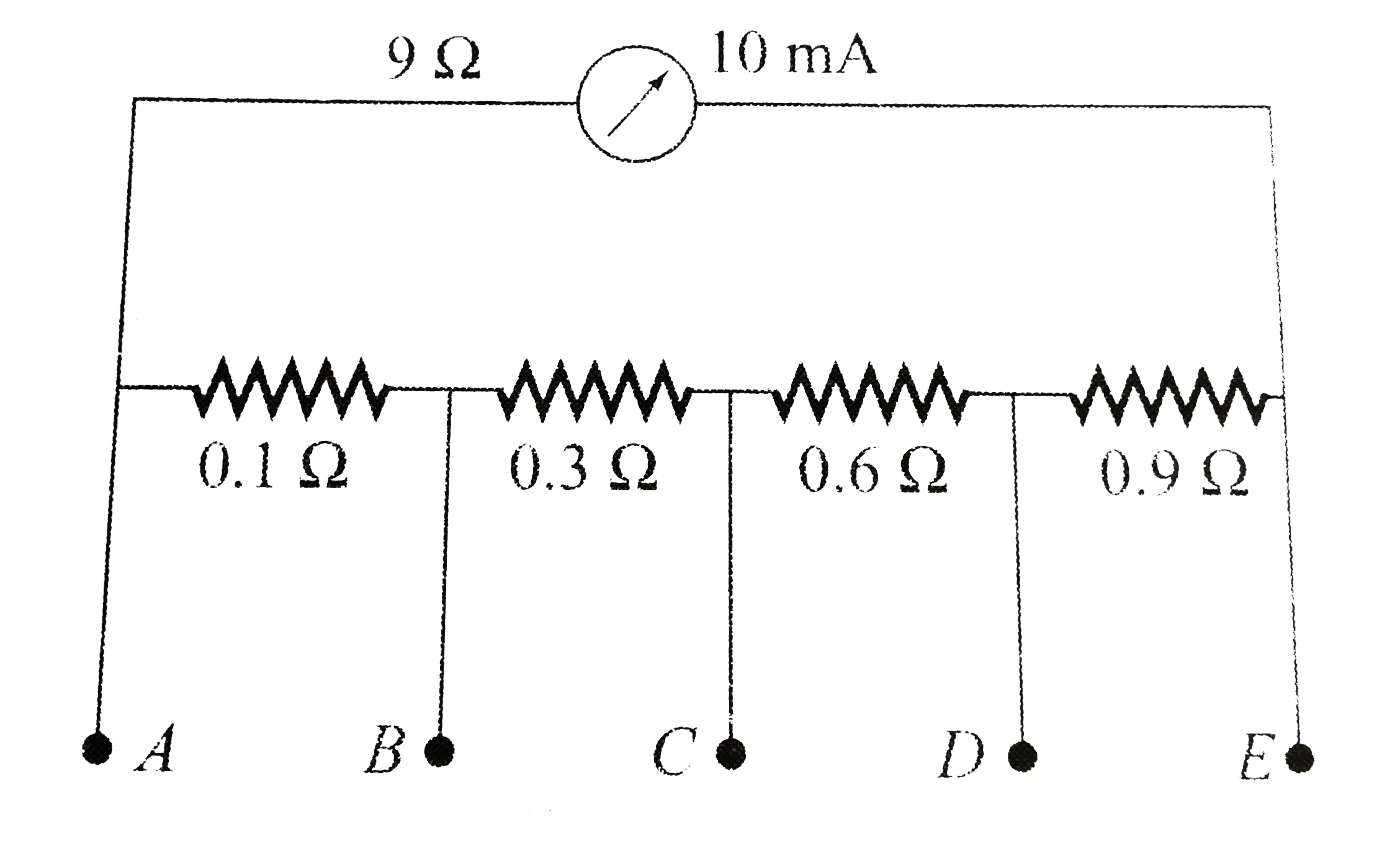A milliammeter of range 10mA has a coli of resistance 1Ω. To use it as an ammeter of range 1A, the required shunt must have a resistance of
1101Ω
1100Ω
199Ω
19Ω
The correct Answer is:C
To find the required shunt resistance for converting a milliammeter of range 10 mA into an ammeter of range 1 A, we can follow these steps:
Step 1: Understand the Circuit Configuration
We need to connect a shunt resistor (S) in parallel with the galvanometer (G) to convert it into an ammeter. The galvanometer has a maximum current (IG) of 10 mA and a resistance (RG) of 1 Ω.
Step 2: Define the Variables
- Maximum current through the galvanometer (IG) = 10 mA = 10 × 10^(-3) A
- Total current (I) = 1 A
- Resistance of the galvanometer (RG) = 1 Ω
- Current through the shunt resistor (IS) = I - IG
Step 3: Calculate the Current through the Shunt Resistor
Using the values defined:
IS=I−IG=1A−10×10−3A=1A−0.01A=0.99A
Step 4: Apply the Voltage Equality Condition
The potential difference across the galvanometer and the shunt resistor must be equal. Therefore, we can write:
IG⋅RG=IS⋅S
Step 5: Rearrange the Equation to Solve for S
Substituting the known values into the equation:
10×10−3⋅1=0.99⋅S
10×10−3=0.99S
Now, rearranging for S gives:
S=10×10−30.99
Step 6: Calculate the Value of S
Calculating the value:
S=10−20.99≈0.0101Ω
Step 7: Final Result
Thus, the required shunt resistance (S) is approximately:
S≈0.0101Ω
We need to connect a shunt resistor (S) in parallel with the galvanometer (G) to convert it into an ammeter. The galvanometer has a maximum current (IG) of 10 mA and a resistance (RG) of 1 Ω.
- Maximum current through the galvanometer (IG) = 10 mA = 10 × 10^(-3) A
- Total current (I) = 1 A
- Resistance of the galvanometer (RG) = 1 Ω
- Current through the shunt resistor (IS) = I - IG
Using the values defined:
IS=I−IG=1A−10×10−3A=1A−0.01A=0.99A
The potential difference across the galvanometer and the shunt resistor must be equal. Therefore, we can write:
IG⋅RG=IS⋅S
Substituting the known values into the equation:
10×10−3⋅1=0.99⋅S
10×10−3=0.99S
S=10×10−30.99
Calculating the value:
S=10−20.99≈0.0101Ω
Thus, the required shunt resistance (S) is approximately:
S≈0.0101Ω
Topper's Solved these Questions
- ELECTRICAL MEASURING INSTRUMENTSBOOK - CENGAGE PHYSICS ENGLISHCHAPTER - ELECTRICAL MEASURING INSTRUMENTSEXERCISE - Multiple Correct
7 Videos
- ELECTRICAL MEASURING INSTRUMENTSBOOK - CENGAGE PHYSICS ENGLISHCHAPTER - ELECTRICAL MEASURING INSTRUMENTSEXERCISE - Assertion-Reasoning
7 Videos
- ELECTRICAL MEASURING INSTRUMENTSBOOK - CENGAGE PHYSICS ENGLISHCHAPTER - ELECTRICAL MEASURING INSTRUMENTSEXERCISE - Subjective
18 Videos
- ELECTRIC POTENTIALBOOK - CENGAGE PHYSICS ENGLISHCHAPTER - ELECTRIC POTENTIALEXERCISE - DPP 3.5
15 Videos
- ELECTROMAGNETIC INDUCTIONBOOK - CENGAGE PHYSICS ENGLISHCHAPTER - ELECTROMAGNETIC INDUCTIONEXERCISE - compression type
7 Videos
Similar Questions
A voltmeter of range 2 V and resistance 300Ω cannot be converted into ammeter of range
View SolutionThe maximum current in a galvanometer can be 10 mA. Its resistance is 10Ω. To convert it into an ammeter of 1 A, what resistance should be connected in parallel with galvanometer (in 10−1Ω)?
View SolutionYou are given two resistors X and Y whose resistances are to be determined using an ammeter of resistance 0.5Ω and a voltmeter of reistance 20kΩ. It is known that x is in the range of a few ohms. While Y is in the range of several thousand ohms. In each case, while of the following two connections (Fig. 6.35) would you choose for resistance measurement? Justify your answer quantiatively. [Hint : For each connection, determine the error in resistnce measurement. The connection that corresponds to a smaller error (for a given range of resistance) is to be perferred.]

View SolutionA galvanometer has a current range of 15mA and voltage range of 750mv. To convert this galvanometer into an ammeter of range 25A, the sunt resistance required is nearly
View SolutionA milliammeter of range 10mA and resistance 9Ω is joined in a circuit as shown. The metre gives full-scale deflection for curretn I when A and B are used as its terminals, i.e., current enters at A and leaves at B (C is left isolated). The value if I is

View SolutionA galvanometer of resistance 40Ω can measure a current of 10mA To convert it into a voltmeter of range 8V the required resistance is ___________ Ω.
View SolutionA milli- ammeter of range 10mA and resistance 9Ω are joined in a circuit as shown in the fig. The meter gives full scale deflection, when current in the main circuit is I, and A and D are used as terminals. The value of I is

View SolutionThe range of voltmeter is 10 V and its internal resistance is 50Ω. To convert it to voltmeter of range 15 V, how much resistance is to be added ?
View SolutionA moving coil galvanometer has a resistance of 990Ω. in order to send only 10% of the main currect through this galvanometer, the resistance of the required shunt is
View SolutionA galvanometer of resistance 40Ω and current passing through it is 100μA per divison. The full scale has 50 divisions. If it is converted into an ammeter of range 2A by using a shunt, then the resistance of ammeter is
View Solution
